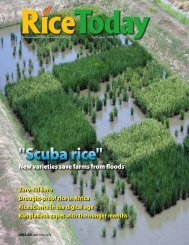How much water does rice need? - adron.sr
How much water does rice need? - adron.sr
How much water does rice need? - adron.sr
You also want an ePaper? Increase the reach of your titles
YUMPU automatically turns print PDFs into web optimized ePapers that Google loves.
That year, around 130,000 visitorssought out this beautiful back<strong>water</strong>to marvel at the arable artwork.In 2006, another revolutionoccurred in this creative corner of thenorthernmost prefecture of Honshu,the largest of Japan’s islands, whenthe organizers for the first timeused computers to precisely plotthe planting of the four differentlycolored <strong>rice</strong> varieties. The result wasan astonishing set of reproductionsof paintings from the famous FujinRaijin Zu Byobu (Wind God andThunder God screens) by the earlyEdo Period artist Tawaraya Sotatsu.Around 200,000 visitors came toInakadate to view the images.“I feel happy to see manypeople come to see our <strong>rice</strong>paddies because, here in InakadateVillage, <strong>rice</strong> and people’s livesare very closely connected,” Mr.Nakayama says, noting that theidea came out of the village’sancient history of <strong>rice</strong> cultivation.“In 1981, when we didconstruction work for a new road,we dug up some <strong>rice</strong> paddies thatarchaeologists dated as being about2,000 years old. That impressedus local people a lot, because werealized how long people have beengrowing <strong>rice</strong> in this place. So then wethought that we had to do somethinginvolving <strong>rice</strong> to revitalize this area.”From that germ of an ideasprang the paddy-art project,which has come to involve notonly local farmers but also manyof their friends and neighbors.Now, the project starts in Aprileach year, when the pictures to beplanted in Inakadate Village’s <strong>rice</strong>paddies are decided upon at localmeetings. After that, six staff at thevillage office make an elaborate planof how to plant different colors of <strong>rice</strong>to create the image. They calculateand plot the precise areas whereeach different color of <strong>rice</strong> <strong>need</strong>sto be planted in the paddies, andproduce a printout of the design thatat first just looks like a mass of dots.Each year, the six village officeworkers spend several weeks of theirown private time, working until lateat night, to complete the plantingplan. Their calculations are not justsimple painting-by-numbers layouts,but include sophisticated use ofperspective so that the paddy picturesappear perfectly proportioned whenviewed from the observation point.“Using computers has greatlyshortened the time it takes tocalculate the position of onedot on the <strong>rice</strong> paddies,” Mr.Nakayama says. “At the sametime, it has made it possible tocalculate many more dots to drawthe picture more precisely.”The 2007 Hokusai designincluded 6,100 dots, compared with1,500 dots in 2005. “If we have moredots for a picture, we can reproducethe original more precisely on the<strong>rice</strong> paddies,” says Mr. Nakayama.Dots on a printout are all verywell—but the most sensitive anddifficult task is digging reed sticksinto the bare spring paddies atexactly the right points so that thosewho plant the <strong>rice</strong> know where toInakadate’s 2008 effort featured imagesof Daikoku (god of wealth; left) and Ebisu(god of fishers and merchants).16 Rice Today January-March 2009

















